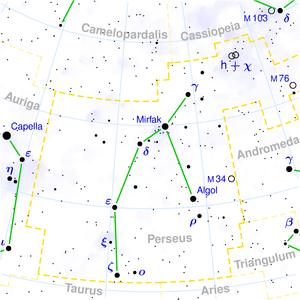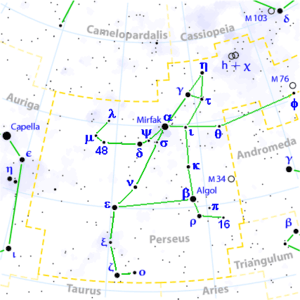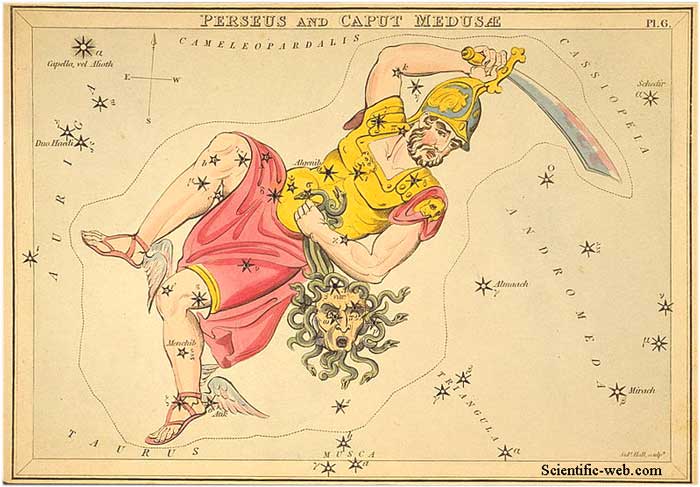
|
Perseus is a northern constellation, named after the Greek hero Perseus who slew the monster Medusa with the help of some godly items. It is one of Ptolemy's 48 constellations and was also adopted by the International Astronomical Union as one of the 88 modern constellations. It contains the famous variable star Algol (β Per), and is also the location of the radiant of the annual Perseids meteor shower. Notable features * α Per (Mirfak): The brightest star of this constellation is also called Algenib (a name which is used for other stars as well, e. g. γ Peg). Mirfak (Arabic for elbow) is a supergiant of spectral type F5 Ib with an apparent brightness of 1.79m lying at a distance of ca. 590 light-years. Its luminosity is 5,000 times and its diameter is 62 times that of our Sun. * Algol (β Per): This may not be the brightest star of this constellation, but it definitely is its most famous star. Algol (from Arabic al-Ghul, which means The Ghoul or The Demon Star) represents the eye of the gorgon Medusa. This star is the prototype of a whole group of eclipsing variable stars. Its apparent brightness ranges between 2.12m and 3.39m with a period of merely 2.867 days. It is a triple star with the brightest component having a spectral type B8 V. The Algol system lies at a distance of only 93 ly. * Nova Persei 1901 (GK Per), a bright nova discovered on February 21, 1901. Deep sky objects * h + χ Per: These two open clusters (NGC 869 and NGC 884 respectively) belong to the most beautiful objects of the night sky for binoculars and small telescopes. They are sometimes called the Double Cluster. Both lie at distances of more than 7,000 ly and are separated by several hundred light-years. * M34: This open cluster with an apparent brightness of 5.5m lies at a distance of approximately 1,400 ly and consists of about 100 stars that are scattered over an area larger than that of the full moon. Its true diameter is about 14 ly. M 34 can be resolved even with good binoculars but is best viewed using a telescope at low magnifications. * M76: This planetary nebula is also called Little Dumbbell Nebula. It measures about 65 arc seconds and has an apparent brightness of 10.1m. * NGC 1499: Also called California Nebula this emission nebula, discovered in 1884-85 by the American astronomer Edward E. Barnard, is a great target for astrophotographers. Due to its low surface brightness it's a very difficult object when observed visually. * NGC 1333 is a reflection nebula and the location of star formation. * NGC 1260 contains the brightest known object in the universe, SN 2006gy. * Alpha Persei Cluster (also known as Melotte 20 and Collinder 39) is an open cluster containing Alpha Persei. Graphic visualization The stars of the constellation Perseus can be connected in an alternative way. Perseus' body is formed by the stars β Per, κ Per, ι Per, α Per, σ Per, ν Per, and ε Per. α Per and β Per are of the second magnitude. The star ε Per is of the third magnitude. The stars α Per, γ Per, τ Per, and ι Per form Perseus' head: gamma Persei is of the third magnitude. Stars γ Per, η Per, and τ Per form Perseus' cap. The stars α Per, ψ Per, δ Per, 48 Per, μ Per, and λ Per form Perseus' left arm and hand: δ Per being of the third magnitude. The stars ι Per, θ Per, and φ Per form the right arm and hand. Perseus' right hand, φ Per, is yanking at one of Andromeda's feet (51 Andromedae), intent on liberating her. (After liberating her, he marries her.) Stars ε Per, ξ Per, ζ Per, and ο Per form Perseus' left leg and foot: ζ Per being of the third magnitude. Finally, stars β Per, ρ Per, 16 Per (with π Per) form Perseus' right leg and foot. Diagram of an alternate way to connect the stars of the constellation Perseus. Perseus and Caput Medusae References * H. A. Rey, The Stars — A New Way To See Them. Enlarged World-Wide Edition. Houghton Mifflin, Boston, 1997. ISBN 0-395-24830-2. * Ian Ridpath and Wil Tirion (2007). Stars and Planets Guide Links
Retrieved from "http://en.wikipedia.org/"
|
|
||||||||||||||||||||||||||||||||||||||||||||||||||||


